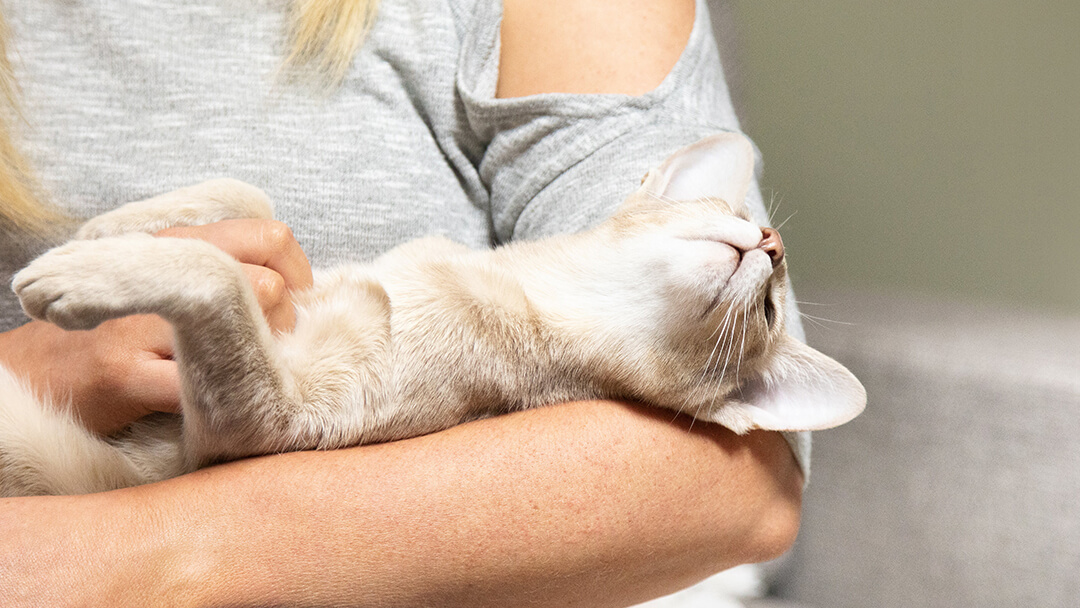

A cat’s enhanced senses are wonderfully intricate mechanisms. Find out fascinating facts about the kitten’s five senses and whether there is a sixth one as some proud cat owners claim.
From playing the piano to performing full backflips and gravity-defying tree climbing, cats are constantly surprising us with their impressive abilities. But behind these amazing skills are the finely-tuned cat senses, honed over thousands of years of being on the prowl.
Our cats have whiskers that work like antennas, ears that act as satellite dishes and a dual scent mechanism that beats even the most nose-sensitive canines. The sensory world of cats is intriguing and, in many ways, unique. Read on to find out how the cat senses work together to bring the world into vivid focus and discover some fascinating facts in the process.
Cat sense of smell
A cat’s power to detect scents is nothing to be sniffed at. With almost 40 times more odour-sensitive cells than our human nose possesses, a cat’s sense of smell is a wonderfully intricate mechanism that some researchers even rank above that of our trusted canines. It’s no surprise then that a cat will rely more on what their nose can smell than what their eyes see to figure out their environment. From mother-offspring bonding to hunting, mating and exploring the surroundings, a cat’s sense of smell is their most reliable tool for picking up vital information.
Outside of social interactions, this powerful sense of smell is one of the best hunting tools a cat could wish for, identifying prey long before it suspects any danger. The same goes for the cat food sitting well-hidden at the back of the kitchen cupboard. Don’t think your cat’s sense of smell hasn’t already identified the precious stash because they can’t see it!
A fascinating fact about cat’s smell sense
Cats have a dual scent mechanism that’s a cool superpower and quite rare in the animal kingdom. Like other animals, cats have regular olfactory (scent) receptors to pick up the aromas in the air. But cats also have a second “nose” located in the roof of the mouth, called the vomeronasal organ. This has a slightly different use as it picks up pheromone signatures that regular scent receptors can’t detect. These pheromones are important for social, mating and territorial information.
Cat sense of sight
A cat’s eyesight might not qualify them for painting works of art, but when it comes to a hunting job in the middle of the night, cat’s eyes are perfect. Their wide field of vision and movement detection abilities make them such proficient hunters. When it comes to cat’s ability to see in the dark, a study found that a huge part of what allows them to operate so well at night is that cats can see ultraviolet light that we humans can’t even detect. However, their daylight eyesight is less heightened as they’re mostly evening and night hunters. Plus, cats have a type of near-sightedness so they can focus well on objects closer to them, but struggle with objects that are far away.
Despite their intelligent eyes, a scurrying mouse might still have a chance of going unnoticed. It turns out cats have a blind spot located right under their chin. So, if your kitten can’t see things right under their noses, now you know why!
Cats can see some colours but not a full range. Green and blue colours tend to fill most of their visual spectrum, with red and pink barely present on their radar. This means that cat toys in blue and green tones will be more visible for them.
Cat sense of hearing
It’s to be expected that the cat’s predatory nature is supported by good feline engineering, and cat hearing is no exception. A small rustle in the leaves on the ground might go unnoticed by humans, but your kitten will quickly perk up their ears and investigate further. A cat’s cone-shaped ears work like a feline satellite dish helping them hear a wide range of frequencies. In fact, they can hear more frequencies than most mammals, including us humans.
The shape of a cat’s outer ear accomplishes two tasks in one: it helps amplify the sound as it’s being passed on to the middle and inner ear, and it detects exactly where the noise is coming from. Hearing is particularly useful when going out to hunt or to avoid being hunted, so no wonder this cat sense has evolved to be an impressive detection mechanism.
A cat hearing myth debunked
If your kitten is white and has blue eyes, you’re likely to be more interested in your cat’s hearing sense than other cat owners. Based on anecdotal accounts, these particular cats have been put in a class apart by cat lovers fearing their looks are somehow connected to an inability to hear. Although there is some evidence that some white cats are more prone to genetic deafness, it’s not true of all cats with these looks.
Cat sense of taste
While most cat senses are very sensitive, taste is the odd one out. They only have a few hundred taste buds, compared to over 9000 taste buds for humans! This means for example that cats are not able to taste anything sweet. However, many believe that their heightened sense of smell makes up for their poor taste.
One thing to keep away from your cat though is anything bitter like lemons or coffee. Their taste buds are not fans of this taste as bitter signals are interpreted to mean dangerous or poisoning food. It’s the same reason why bitter liquids and sprays are sometimes used to dissuade cats from biting and chewing furniture or wounds.
A unique taste sense
Experts believe that cats lack the sweet gene that allows them to taste sweet food, and that they might be the only mammal in this situation. Although some owners can swear their cat has a sweet tooth, it’s quite possible that the fat content is what makes these sweet foods attractive to them, not the sweetness itself.
Cat sense of touch
The cat’s sophisticated sense of touch is always there to support and enhance their vision. Whiskers are a cat’s trusted radar and work as touch receptors that help them measure distances accurately. If you see the cat successfully navigating impossibly narrow spaces or gracefully leaping on thin ledges, whiskers are the ones putting in the hard work. Read more about why cats have whiskers with our guide.
Touch receptors are also present on their nose and paws. A cat’s fur itself contributes to a heightened sense of touch as it’s always picking up sensory information. It’s why your cat responds by purring everything you stroke or pet them.
A surprising fact about a cat’s sense of touch
You probably think of your cat’s whiskers as a facial feature. It turns out whiskers are also present on cat’s front legs. They come from a time when cats did a lot of chasing and hunting and the front leg whiskers are crucial for detecting the position of the prey they’re about to catch.
Cat’s sixth sense
Cats are mysterious creatures, and most owners find themselves wondering what they see when they stare at the couch so intently or what they’re trying to catch with their paws up in the air. We can’t fully explain kitten behaviour which is why many owners ended up believing there’s a special ability, a cat’s sixth sense, which can explain it all. Despite some cat lovers claiming they witnessed their cat predicting imminent danger or communicating with persons unseen, there is no solid evidence that cats are able to detect things beyond what the usual five senses are capable of.
But there is an important job our dear felines can be trusted with that gets them pretty close to magic. Studies have revealed that pairing a kitten with an autistic child or even with a dementia patient can be extremely beneficial. The special cat-patient connection is able to transform lives, so even if a cat’s sixth sense doesn’t exist, our felines are still amazing creatures.
So there you have it: the extraordinary cat sensorial abilities. Continue the journey into the fascinating world of cats with these fun cat facts or get to know the feline psychology better for your kitten’s emotional wellbeing.















